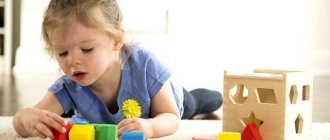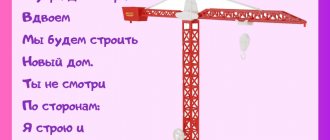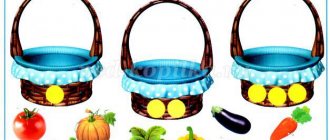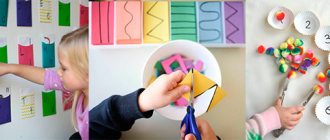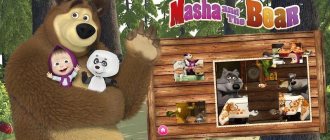Development of memory in preschool children. It is impossible to imagine a mentally healthy person without memory. This simply cannot happen. After all, memory is a tool with which an individual can apply his experience and rely on previously acquired knowledge. It is important to teach your memory to work correctly so that it does not fail. For this, a fertile period will be preschool age, when the emergence and development of mental activity occurs.
Features of memory development in a preschool child
Each time period of a person’s life is different from others, because at each stage new knowledge comes. In addition, the ability to remember depends on a person’s physical and mental abilities. In preschool age, memory is excellent, the child literally grasps everything on the go. Everything he learns interests him; this is the process of cognition. But what seemed uninteresting will remain overboard.
Memory is a meaningful action. If a child does not understand something, he will not remember it. Involuntarily, things that touched and impressed the child are remembered. And in order to remember something that, in a child’s opinion, is not at all interesting, you need to work hard. Meanwhile, the child who is already learning to analyze, compare, generalize, and masters other operations of mental activity remembers better.
Bright pictures are very important for children; their eyes catch colorful illustrations, and their brain forces them to put these images in their memory. Movement also helps memory. A child cannot be passive, so outdoor games and exercises help develop his memory.
The first important stage in the period of growing up of a preschooler appears at the age of four. If before this period there were first actions that gave rise to memorization, then in the middle group of kindergarten the child can already remember the words spoken to him and perform some actions based on instructions. He can even plan some actions himself based on the remembered material, and first of all, the support for these memories will be the child’s personal observations.
At the age of five, a preschooler comprehends logical memorization; adults help him with this when they give some instructions or explanations for any actions. During this period, the interaction of mental operations is important.
Benefit
Games that develop memory are the most popular. This is the leading activity for children, so their enthusiasm is not surprising. But why are they preferred by older and older people? They just have undeniable advantages over the same finger and speech gymnastics, daily exercises, logical puzzles and even mnemonic techniques:
- this is an interesting and exciting process that makes you take your mind off problems;
- it relieves fatigue and tension, combining relaxation and benefits at the same time;
- their rules are usually simple and can be learned by everyone - children, old people, people with disabilities;
- competitive spirit is a good motivation to do everything perfectly and achieve the desired result;
- Team games always mean communication, the ability to find contacts with other people, which also has a positive effect on the development of brain activity, and therefore memory too.
How exactly does play help develop memory?
Rules control the behavior of participants, not allowing them to go beyond what is permitted - they must be constantly kept in mind while simultaneously performing other actions.
Overcoming obstacles and the ability to control your negative emotions in the event of failure or loss contribute to the development of those same neural connections. They force one to draw conclusions about mistakes made - a person remembers them so as not to make them next time.
The game requires you to look for ways to solve a given problem, either as a team or independently. Sometimes conditions change rapidly and unexpectedly, to which you need to adapt just as quickly. The result is the development of creativity, initiative, intelligence, and with them attention, thinking and memory.
Most games require maximum concentration, so they can be used to develop memory and attention at the same time.
The result of regular use of gaming activities as a simulator for memory development is an improvement in mental abilities and cognitive mental processes. This will manifest itself in literally all areas: in everyday life, when you don’t have to once again stand in the store and remember what you should have bought; in studies, when the material will be easily remembered; at work, where you always need to be prompt; in relationships, so as not to forget the wedding anniversary or birthday of a loved one.
Types of memory
Development of memory in preschool children. There are several types of memory.
- motor,
- emotional,
- verbal-logical,
- figurative.
In turn, it is necessary to note involuntary memory, when images and objects are remembered as if by themselves, without any effort, and voluntary, when a diligent process of memorization is underway. Involuntary memory is typical for younger preschoolers. Older preschoolers are already beginning to master voluntary memorization.
Emotional development of a preschooler
Reproduction forms
Forms of reproduction can also be divided into groups.
- The simplest thing is recognition. If a person has seen or heard something before, he will certainly recognize it.
- The second form is memory. For memory it is not important to see the object. It is important to remember its signs.
- The third form is recollection. In this case, remembering can be difficult; in order to remember, you need to make an effort and character.
- The fourth form is forgetting. It is impossible to remember everything all the time. Forgetting is the case when the brain refuses to remember the characteristics of an object or replaces one object or phenomenon with others because recognition is blurred.
In preschoolers, figurative memory dominates. He remembers the signs of an object and phenomenon, if they are vivid and catch his imagination. Can remember minor details, but most importantly, forget important things.
In addition, when working with children, you need to remember another feature of the children's brain: selectivity. Everything that is interesting to a preschooler is remembered without difficulty. Everything that is boring and uninteresting is immediately forgotten, because there is no fixation on its main features.
The third feature: repetition is the mother of learning, teachers say following the author of the historical phrase. If a child repeats the same actions over and over again, he automatically remembers.
The fourth distinctive feature of a preschooler’s memory is that emotional influence leads to memorization. What touches you cannot help but leave a trace in your memory.
When the amount of information accumulates, with the development of perception, the child is able to master coherent and systemic ideas. And the next step will be meaningful operation of the acquired knowledge.
Norms of memory development in preschoolers
For a specific age stage there are different norms.
- Up to a year - motor memory, there are reflexes, memorization at the level of emotions.
- 1-2 years – development of the nervous system, figurative memorization.
- 2-4 years – development of mechanical memory, memorization and logical thinking skills, recognition predominates, interest is important for memorization.
- 4-5 years – involuntary memorization, voluntary begins, recall prevails.
- 5-7 years - arbitrary. The volume of normal memorization is from 8 out of 10 items.
Developmental techniques for children
Perform developmental exercises from Ikyusha
Mathematics
Reading
The world
Logics
English language
Anagrams
Age: from 5-6 years
Anagrams are the rearrangement of letters in a word to form a new word. For example, sleep is nose, rakask is paint. Anagrams work well for children who can already read.
Such tasks increase concentration and speed of thinking, and also develop visual memory.
Schulte tables
Age: from 5 years
Many parents have heard about Schulte tables. These exercises are very popular as they increase concentration and develop memory in a light playful way. The child’s task is simple - to find in order the numbers or letters randomly located in the table. The sizes of the table vary depending on the age and preparation of the baby (usually from 3x3 to 16x16).
Exercise “Listen and count”
Age: 6-8 years
Another great exercise for focusing attention. You read the sentence while tapping your pencil or pen on the table. The child needs to remember both the text and the number of your strokes. If the baby begins to cope easily, complicate the task by gradually increasing the number of blows.
How to measure a child's memory
Development of memory in preschool children. You can measure your child's memory using special tests.
Visual memory
The child is invited to look at the pictures. It will take one and a half minutes to open. Then the child is asked to draw from memory what he saw.
If the child correctly drew most of the objects, his memory is good. If not, there are memory problems.
Another option is to show the child pictures, ten in total. Then they ask him to name the objects he saw.
If the child correctly named more than 8 pictures, his memory is good. If you made a mistake about five times, the result is average. If you made more than five mistakes, then your memory is bad.
Auditory memory
The teacher calls out the numbers, the child must repeat after him. If the child names at least 5 numbers from a series correctly, then his memory is good.
Recognition test
The child is shown a picture depicting certain objects. Then he is asked to find these objects in a large picture.
If a child managed to find at least eight out of 10 objects, his memory is good. Made more than five mistakes - the result was weak.
Exercises and games to develop memory
Remembering that it is easier for a preschooler to remember things that he understands, you need to build the learning process through play, based on motor activity and emotions caused by interest.
Development of figurative memory
Development of memory in preschool children. The child’s ability to involuntarily memorize objects can be used in the “Classification” game. In this case, the child is offered several pictures with images of some objects. The child needs to arrange the illustrations into groups. For example, he must arrange pieces of furniture into “rooms”: bedroom, living room, kitchen, bathroom. Or there are pictures of animals. The child should put domestic animals in the “house” and wild animals in the “forest”.
The game “Shop” will help to develop figurative memory. The child shopper “does” the shopping, who must put into a basket the items he was told to “buy.”
Development of imagination in preschool children
Development of auditory memory
When a child hears some information, he mentally processes it and only then takes action. What if the child does not know how to listen and hear? Then there is no need to talk about his future success at school. Therefore, it is very important for preschoolers to develop auditory memory. You can use these exercises.
Verbal relay race
In this game, the leader names a word. The child must repeat the word that the leader said and say his own word. Then it’s the presenter’s turn. He names these two words and adds a third. Child's turn: he repeats all the words and adds a fourth word. It is desirable that the words be on a specific topic: “Summer”, “Vegetables”, “Transport”, “Dishes”, etc. The one who made a mistake, knocked down the verbal chain, lost.
Game of colors
In this exercise, the child must color the picture. But before that, he listens to a text passage that talks about the plot in the picture and names the colors. For example, in the picture there is a house with a brown roof, red apples grow on the tree house, and blue flowers grow in the clearing. In order to color the picture correctly, the child must remember the text.
Tact
Clap your hands or knock with a hammer, beating time. The child must repeat the sound combination.
Children's games in memory formation
Outdoor games for the development of preschool children
Children in preschool age move a lot, so outdoor games or play exercises with objects: a ball, pins, hoops will be relevant. The main thing is that the games are appropriate for the child’s age and are selected by parents in accordance with the rules.
"Mirror"
A relevant game for kids when they need to develop memorization, retention, and motor memory.
The adult says to the child: “Let's play in the mirror. Remember what movements I show you and repeat them.” The child performs movements, at first simple, then, as the rules are mastered, more and more complex.
For older children, such fun can turn into an intense game of “Forbidden Movements”, when, on the contrary, the shown movements cannot be repeated.
Ancient ball game "I know..."
This game can be offered to children of all ages. The fun is aimed at developing auditory memory, mental activity and coordination of movements. The child hits the ball on the ground and, in time with the hits, pronounces the words: “I know three names of girls (boys).” Names cannot be repeated.
As an option for the game, you can use the names of cities, vegetables, fruits, flowers, etc. For older children, the number of items increases to 5.
"Ocean is shaking"
A classic game exercise to develop the processes of memorization and reproduction. It is better to spend it with a group of children of different ages: on vacation, in the family circle, during a children's party.
The players make up different figures. The driver closes his eyes and says: “The sea is worried - one, the sea is worried - two, the sea is worried - three, the sea figure freezes in place.” Children perform various movements: run, jump, squat. At the end of the words, everyone stops in a certain position. The driver opens his eyes and carefully examines the “frozen figures.” He must remember how the players were positioned and correct their positions.
"Restore your figure"
Playing with pins in a small town style helps develop visual memory, memorization and reproduction processes.
An adult and a child build a figure out of pins and ask them to remember it. Then the figure is knocked down with the ball, the child must restore it. The fun takes place interestingly in nature, in the family circle, during outdoor holidays.
Story games for developing memory processes
Story play is a favorite leisure activity for preschoolers of all ages. Such games are related to life situations, and therefore arouse genuine interest in children. Parents can successfully use story activities at home. When playing with kids, you can take on one of the main roles in the plot. With older children, adult participation may be sporadic. You need to start playing games with kids with simple situations, using familiar household items, dishes, and cereals.
"Shop"
The plot develops all processes: memorization, preservation, reproduction, and helps to form auditory memory. Children of all ages can play.
With kids, the parent takes on the role of a seller, offering to remember what needs to be bought in the store, for example, for pies. Older children can play the leading role themselves, inviting others to make various purchases. In the game you can teach children special memorization techniques (mnemonics). For example, invite a preschooler to prepare a note with symbols of purchases.
"Hospital"
Another story-based game that preschoolers love to play. It helps to develop all memory processes, auditory and visual. The adult invites the child to take on the role of a “doctor,” remember how he is treated when he is ill, and then cure the “sick” bear. First, you need to discuss with the baby the sequence of all actions: first put the “sick” to bed, listen with a phonendoscope, measure the temperature, put a tablet under the tongue, prepare a mixture, etc.
"Holiday"
The game is interesting for all children, but older preschoolers can prepare it on their own. With kids, an adult must be extremely active, since all actions require special preparation: attributes, drawing invitation cards, arranging a play space. The plot can be varied: a New Year's holiday, a doll's birthday, a festive tea party, etc. Guest toys are prepared, the actions of the players are discussed, and roles are assigned. The game will be more fun if children of different ages take part in it.
"Zoo"
An exciting game for children of different ages, it helps develop the processes of attention and memory: preservation, reproduction, and combating forgetting.
The preschooler needs to remember what animals live in the zoo. For the game, you can prepare pictures of animals or animal figures. An adult and a child walk around the zoo, examining its inhabitants, remembering their habitat, appearance, and habits. After some time, the preschooler is asked to look at pictures with different animals and remember which ones were in the zoo and which ones are yet to be placed there. This game takes a long time because the plot is constantly updated. Riddles about animals are good for developing the plot. They not only enrich the preschooler’s speech, but also help form the processes of memorization and reproduction, and teach mnemonic techniques (associations, comparisons, grouping). For example, “Instead of a nose there is a trunk, instead of legs there are pillars, and they stand like gray mountains...”, “He walks in our zoo, he surprises with his long neck. It’s tall, like a closet, yellow, with spots...”
In the plots of such games, you can also use folk nursery rhymes, songs, and rhymes, which help improve the memory of preschoolers and form memorization skills. For example, “preparing lunch”:
Carcasses-tattoos, Baked cheesecakes! They put it on the window and left it to cool. And the wheat pie - It is mixed with maggots, So high, high!
Or “we’re going to visit”:
The gray bunny is dressing up, apparently going to visit. I washed my nose, washed my forehead, washed my ear, wiped it dry. He put on a bow and became a dandy.
Didactic games for memory development
There are special (didactic) games aimed at improving all types of memory. Basically, they are educational in nature and require special training and the necessary gaming material. Despite the rather large time investment, didactic games give good results because they are both exercises for memory development and games for the development of all mental processes in a complex.
"Wonderful bag"
The classic game in various versions can be played with three-year-old children who have ideas about the world around them. The parent invites the child to find an object by touch and tell about it from memory without removing it from the bag, for example, a round smooth ball, a soft fluffy toy, a wooden cube, etc. Older preschoolers can be offered new and complex objects that differ from each other in shape, quality, size: smooth and rough, cold and warm, ball and cube, metal and wood, small and large toy.
"Guess what's changed?"
The game has become a classic in pedagogical practice and is relevant for younger preschool children who are just beginning to learn about memorization techniques. The parent invites the child to remember and count by order (first, second, third, ...) the toys that are in front of him. Then the child closes his eyes or leaves the room, and the adult changes places or hides a toy. Kids like to guess what has changed, what is missing, and where this or that toy is now.
"Lotto"
The game develops visual memory, teaches memorization techniques (multiple repetition, grouping of words, generalization). An adult and a child play together, the one who covers his playing field faster wins. The subject can be objects of different classifications: vegetables, fruits, animals, furniture, clothing, natural phenomena.
“Cut pictures” or puzzles
Games of this kind are accessible to children of all ages; they help develop all mental processes in a complex: you need to be attentive, remember which part of the picture is collected, correlate the sample and the collected part of the picture.
Creative games for older preschoolers
Starting from senior preschool age, children can be offered verbal educational games. They help not only to develop auditory memory, but also to consolidate the skills of using mnemonic techniques (associations, grouping, generalization).
"Magic Words"
Option 1 – association game. The presenter thinks of a word, breaking it into syllables and making a new word from each part. Players must guess the hidden concept using association words. For example, the word “airplane” is thought of: sa (sledge) - mo (milk) - let (fly), associations are suggested:
Sleds - everyone loves to ride them down the hill. Milk - cows provide healthy liquid to children. Fly - butterflies, birds, beetles do this.
Ultimately, the intended word is assembled from the syllables. The winner receives a forfeit.
Option 2 – the words that are offered to the baby are remembered using generalization words. You can ask the child to name the extra object, to name the objects in one word. For example, “maple, birch, linden, poplar, spruce, aspen (all deciduous trees, and spruce is a coniferous tree)”, “red, white, orange, blue, pink - colors.”
Option 3 – words – “C”, memorizing words using grouping according to some attribute. For example, cow - milk - cottage cheese, paper - pencil - drawing, flower - vase - mother, summer - sun - water. The presenter offers to remember three words, connecting them with a plot, and remember the rest based on the first word. To develop memorization skills, the game begins with two “C” marks, then their number gradually increases. The player who groups and remembers the words best wins and receives a prize. If it is difficult for a preschooler to concentrate on the educational material, at first you can offer support for pictures.
Development of visual memory
Development of memory in preschool children. Bright pictures attract children's attention, but are kids able to retain the image in memory? To develop their abilities, you can invite preschoolers to play the following games:
"Restore the pattern"
A pattern is laid out on the surface using painted parts. The child remembers it. Then the child is asked to lay out the same pattern from memory.
"Scout"
There are objects on the table. The child looks at them and remembers what and where it is. Then the child turns away, and some objects are swapped. The child must name the objects that were moved.
"Walk"
While walking, the child sees many colors and objects, he involuntarily remembers what attracted his attention. An adult should help focus attention. After the walk, you can ask your child to draw what he remembers.
Educational games and exercises for training visual memory
"Find the Differences"
The task is accessible and interesting for both kids and older children.
An adult selects two identical pictures with a certain subject or plot, but differing from each other in some details. For three-year-old children - up to 5 differences; older preschoolers can be offered 10 differences. Parents should take into account that for children the images should be large, without small details, since children are still learning to concentrate on the subject. Exercises should be carried out as often as possible, gradually complicating the plot.
"Photographers"
The exercise is intended for middle and older preschool children who are already beginning to develop voluntary actions. An adult gives instructions, asking to look at a card divided into two parts. On the left are cells with depicted objects. On the right are empty cells in which you need to draw memorable figures. The child looks at the images for 10 seconds, trying to remember them. Then the left part with the drawings is closed, and the empty cells are filled with drawings. At the initial stage, it will be difficult for a preschooler to remember the images, so the exercise must be repeated quite often. To maintain interest, you need to change the pictures, introduce a competitive element to see who can remember the most figures.
"Symmetrical drawings"
The task is quite difficult, but it develops well the memorization of visual images, teaches you to concentrate on an object, and strengthens motor skills.
An adult prepares a symmetrical drawing for a preschooler, which is divided in half by a vertical line. The left half is painted, the right half remains unpainted. The child is asked to carefully examine and remember how half of the figurine is painted. Then the left side is closed, the right side is painted in the same way. For very young children, you can use this task, but the proposed item should be quite simple and understandable: a vase, a ball, a flower, a cube, a sun (2 colors). For older preschoolers, the image becomes more complex, the number of colors gradually increases to 5, for example, a human figurine, a house, a complex flower, a multi-colored vase, a butterfly, a geometric pattern.
As a variant of the game, you can invite children to complete a symmetrical picture when only one half is given. You just need to remember that a symmetrical object should not have too many small details. For example, the following objects are offered for drawing: plate, chair, daisy, house, Christmas tree, bee.
"Let's help the artist"
The exercise helps develop visual sensations, short-term memory, and attention. The task comprehensively develops imagination and motor skills. An adult selects drawings that lack some details, for example, a teapot without a handle, a flower without leaves, a house without windows. Children are asked to help an absent-minded artist who forgot to draw the details. For older children these could be story pictures:
- the dog sits near the booth, which has no hole;
- a house with a fence that is missing several planks;
- the girl has a handbag without a handle in her hands, no shoes on her feet;
- boys are playing football, but there is no ball, one player is missing sneakers.
Parents can pick up similar stories from children's magazines or draw them themselves. The main thing to remember is that the complexity of tasks should increase gradually: drawing parts begins with one, gradually moving to three or more parts.
“Why so much confusion?”
A game similar to the previous one also contributes to the development of visual memory in preschool children and the formation of attentiveness as a personality quality. An adult selects pictures that depict objects or fairy-tale characters with incorrectly drawn details, for example, Cheburashka has a long tail, like a crocodile, a girl’s cap is on the wolf’s head, sheep are sitting on a branch, a mouse is chasing a cat, and the like. The child is given instructions: carefully examine the drawings and correct the artist’s mistakes. This game amuses the kids and brings them pleasure, so the drawings can be given for independent drawing.
"Cut pictures"
A classic educational game for visual memory and attentiveness for both very young children and older preschoolers. The task is that the children are offered a set of cards and a plot picture. You need to carefully examine it and collect a similar one from individual cards. Using the same principle, you can collect pictures - puzzles.
“Matches are not a toy, but training”
Games with matches are of great benefit for training visual memory, attention, and motor skills. Such fun is good because it does not require long preparation; it can be done anywhere: on vacation, on a walk, during family leisure. The presenter distributes a small number of matches to all players, then throws several of them on a flat surface. The players carefully examine the resulting combination, then the matches are closed. Everyone is trying to repeat the layout of matches. The one who gets it most accurately wins. You can celebrate the winner with a prize, especially if it is a child. In the future, the number of matches increases, the situation becomes more complicated. Fun with repeated repetition brings good results, and game elements allow you to form arbitrary actions.
Development of motor memory
To develop motor memory, you can play “puppet”. The child stands calmly, and the adult controls his arms and legs, forcing him to go right, left, forward. Then the child is asked to repeat the movements from memory.
You can also use the game “Do as I do.” The teacher makes the movements, the child repeats after him.
Developmental activities for preschool children
Development of arbitrary logical memory
The ability to classify leads to the development of arbitrary logical memory, so it is important to give children exercises where they must use methods of classification, analysis, comparison and generalization.
Didactic game "Cards"
Children are asked to select images based on specific characteristics and arrange them in piles. For example, from pictures with birds and animals, you need to put pictures with birds in one group, and pictures with animals in another. Themes for the game can be different: sports, furniture, seasons, plants, etc.
"Twins"
Among different pictures, the child must find two identical ones.
The purpose of games that improve attention and memory
The main goal of games and exercises for memory development is to prepare the child as much as possible for a large amount of school information and extracurricular intellectual loads. The standardized training system primarily relies on vision and hearing.
Therefore, children with visual and sound vectors learn it more easily than others. However, if children are offered games to develop memory from an early age, then carriers of the remaining vectors will be quite capable of mastering the educational material to their full extent.
Games for children that develop attention will also have a positive effect. After all, the process of memorization first involves the child’s voluntary concentration on the information received. For this reason, games for attention and memory are often combined together as helping to master the skill of voluntary concentration and memorization.
Development of long-term memory
Development of memory in preschool children. To develop long-term memory, you need to teach a child not only to recognize, but also to reproduce information. Long-term memory is impossible without expanding the horizons of a preschooler. In this case, exercises with texts and illustrations help.
Preschoolers are offered several pictures depicting animals and various objects. And there is a suggestion: remember all the animals, for example. Or remember all the dishes that are in the pictures and then name them.
A good option would be to compare pictures that differ in minor details.
Exercises to develop auditory memory
- "Words" . This game is very similar to the well-known game "Cities". It not only develops the child’s memory, but also promotes the transition of words from a passive to an active vocabulary, and also improves phonemic hearing. So, name the word and ask your child to come up with a word starting with its last letter. Then you do it, and so on in a circle. Another version of this game is to name words starting with one pre-selected letter.
- "10 words" . Invite your child to remember 10 words that are not related in meaning. Read the words at a moderate pace, taking a short break between them.
- Retellings.
- Learning songs and poems.
- "Remember how your day went".
Methods for developing tactile memory
Tactile memory is a person’s ability to remember the sensations of touching a particular object. To develop tactile memory you will need the following exercises:
"Find by touch"
The child is asked to choose one from a variety of objects based on specific tactile characteristics. For example, a child is told that this object is soft and fluffy. Or rough, prickly.
"Game with mood"
The child has associations about objects. If an object is soft and pleasant to the touch, then this object is in a good mood. Which object is in a sad mood? Or evil? The child, relying on tactile sensations, selects objects.
"Tales with tactile details"
In this case, the child participates in a theatrical production, where the plot of a fairy tale is heard, and all the characters and objects surrounding them can be touched and determined what they are: soft, rough, hard, prickly, etc.
Games to develop fine motor skills in children
Memory impairments and their causes
Experts distinguish two main types of disorders:
- quantitative,
- quality.
Quantitative disorders are a weakening of memory, loss of any fragments. With high-quality ones, false memories and fantasies come first, replacing reality.
The causes of memory impairment in children can be:
- mental retardation, often congenital,
- trauma, physical or mental,
- an atmosphere that is not comfortable for the child, where fear displaces everything from the child’s head,
- soreness of the body, including vitamin deficiency.
Developing a baby's associative memory
- “I know five... ” The game is to repeat the name of something while hitting the ball. For example: “I know five cities: Moscow one, St. Petersburg two, Vologda three... and so on.”
- "Name a couple" . Give your child 5-6 pairs of words that are related to each other in meaning (for example, soup - spoon, winter - snow, TV - cartoons). Then ask your child to remember the second word from each pair in response to the first. Gradually the number of word pairs can be increased.
What affects the development of memory in a child
Development of memory in preschool children. In order for a child’s memory to develop, you need to pay attention to the following factors:
Nutrition
The diet should be varied, healthy foods and vitamins should be included in the diet. There must be meat and vegetable products, fish, herbs, and fruits.
Healthy eating: menu for every day
Healthy lifestyle
There must be a daily routine in which you need to devote time to both walks and useful activities. The child should go to bed at a specific time and get up at a specific time. Let the child participate in a sports section or attend a development club.
Development taking into account the age characteristics of the child
Parents must understand that the child must direct his energy in the right direction. However, you should not overtire your preschooler, otherwise you may end up with constant fatigue syndrome. It’s good if developmental classes take place in a kindergarten. It is impossible to overwork a child by enrolling him in several sections and clubs at once.
